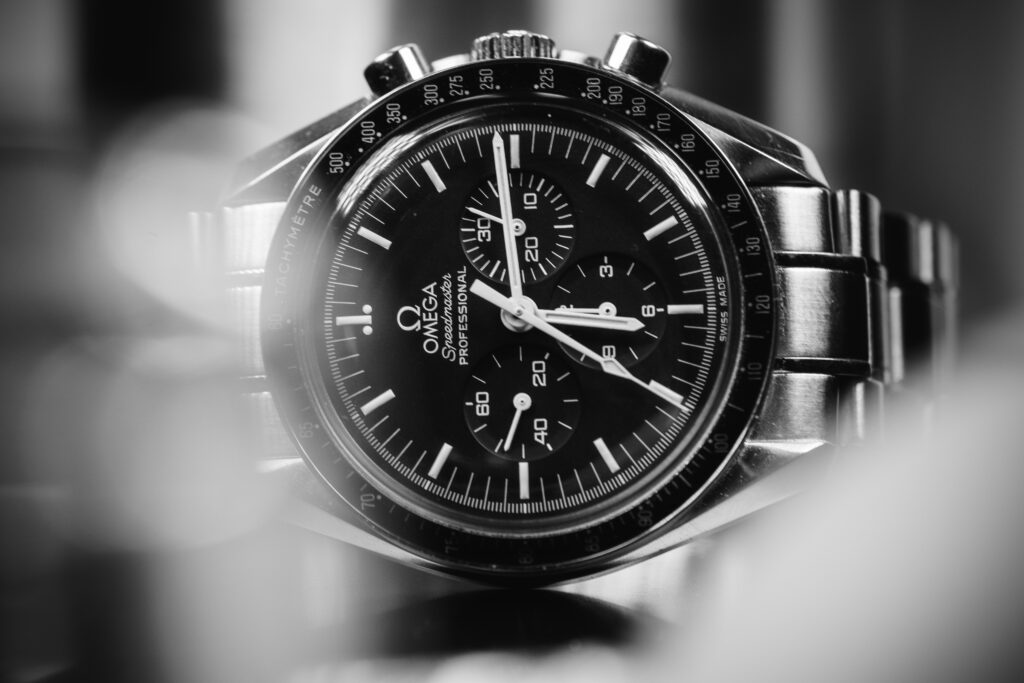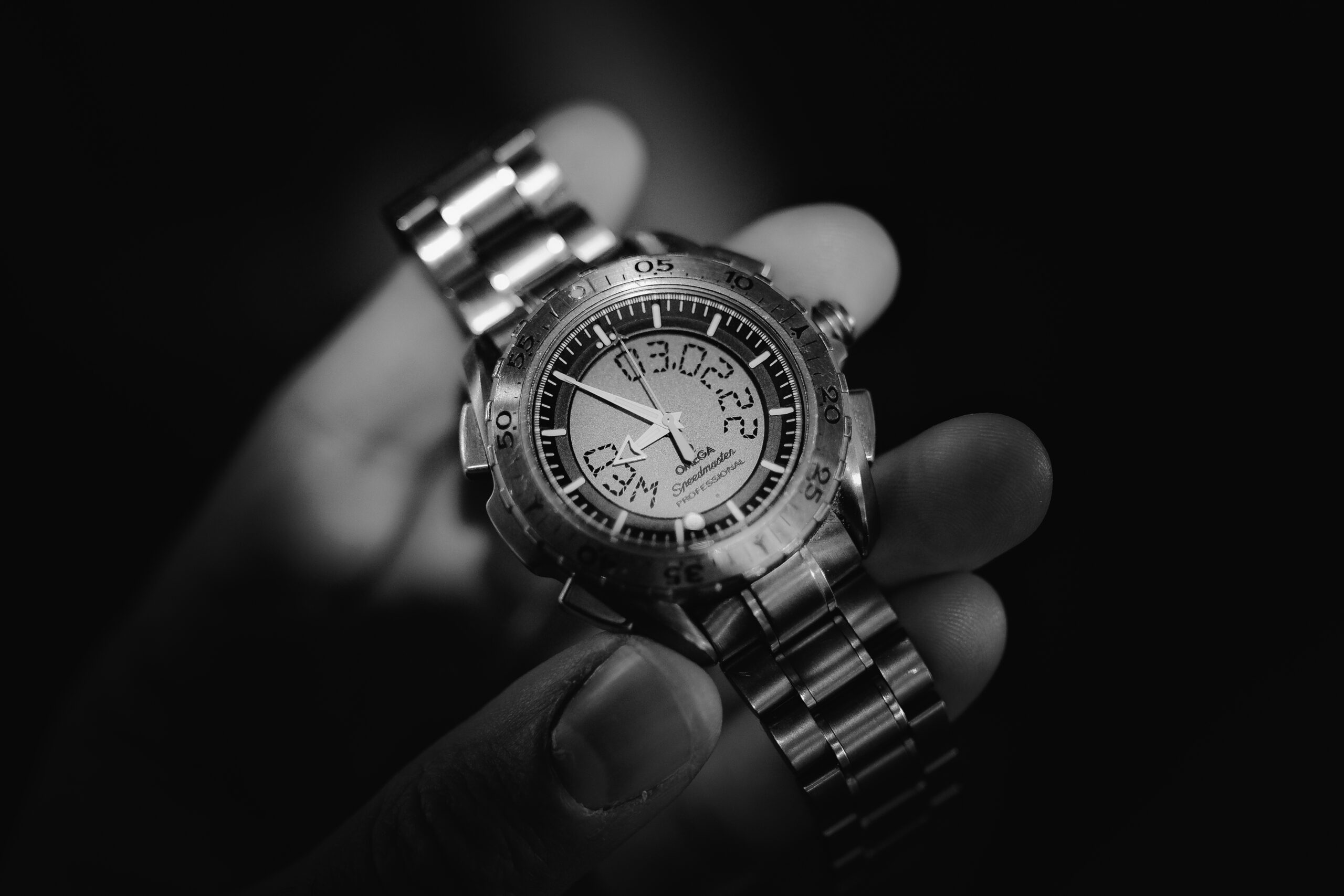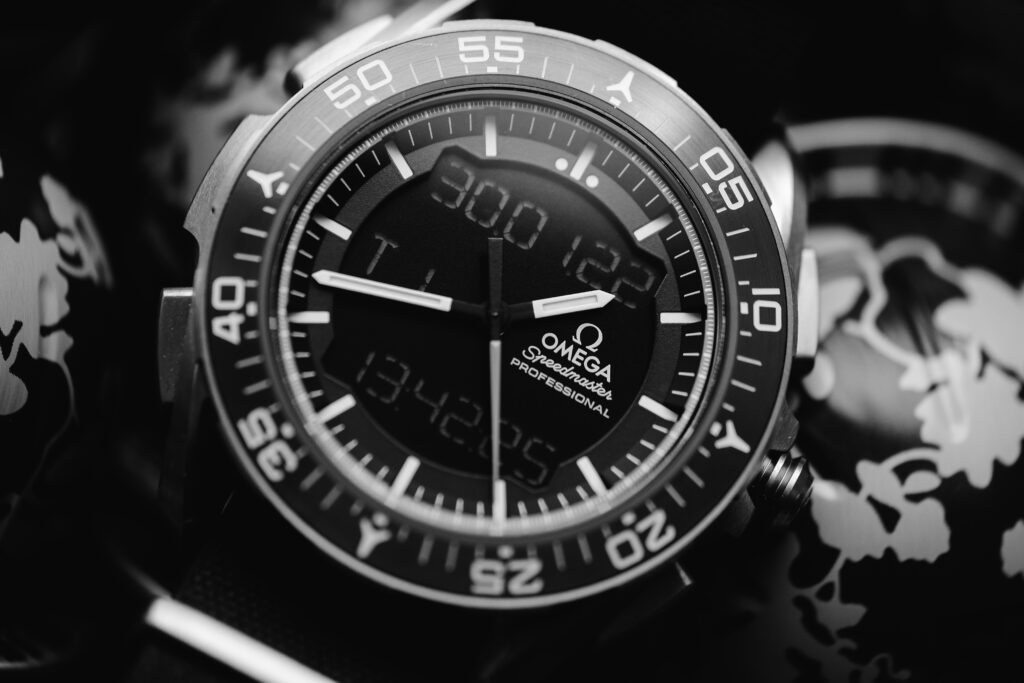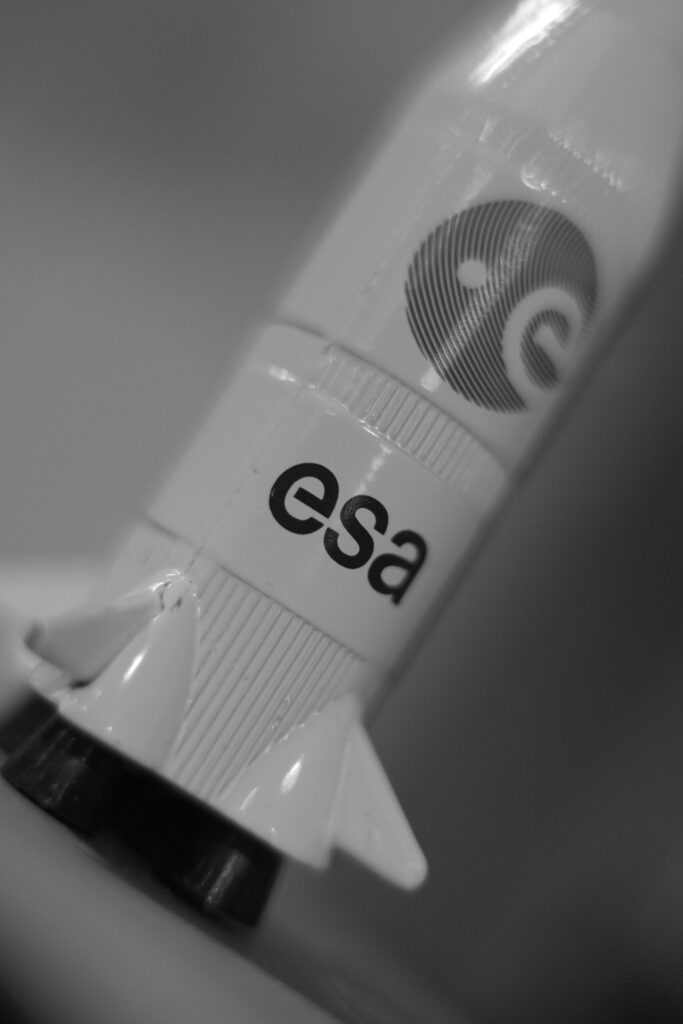3023 words
The purpose of this article is to highlight the continued and important contributions that Omega has been making in space exploration, how they can better make the public aware of this, and how they can improve an existing watch model. The Omega Speedmaster X-33 centres on the frontier of science and the vital work being accomplished in space. Furthermore, I will discuss how the marketing-driven focus for the X-33 is potentially detrimental to this timepiece’s legacy, much like how it is for the American space program.
The watch in question is a Speedmaster, but not the original Speedmaster Professional, known as the Moonwatch, which was used by NASA on the initial moon landing and for the subsequent decades following it. This timepiece is the Speedmaster X-33. A highly focused instrument specifically made for use by pilots and scientists on their way to space stations and to conduct the most advanced scientific research for our species.
The X-33’s legacy itself is one worth celebrating. This legacy is cemented not only in history but also in the ongoing geopolitical atmosphere and its dire consequences. More importantly, the X-33 could be used to celebrate the brightest minds our species has to offer. If Omega and its space agency partners go down this path, the scientific community for this generation and beyond would benefit.
In this article, I shall explore how the X-33’s seemingly disappointing Mars-driven legacy is, in fact, quite the opposite. This fascinating legacy makes for a far more interesting, captivating, and intricate narrative than even the original Moonwatch.

The mechanical Omega Speedmaster Professional Moonwatch
Omega initially marketed the X-33 as the “Mars Watch” to sit alongside the aforementioned Moonwatch. The goal was to capture the imaginations of potential customers and the hope of humankind eventually setting their feet on the surface of Mars. Twenty-four years later, the fourth iteration of the X-33 was released, named the “Marstimer.” This watch would not be used by humans on the surface of Mars, for we have not even come close to making such an attempt. Rather, it is for the scientists of the European Space Agency on Earth to track rovers on the surface of the Red Planet. Thus, laypeople watching from a distance may view the legacy of the X-33 as one of disappointment.
Before we get started, let us first cover what an Omega Speedmaster X-33 is. You can read my in-depth review of the very X-33 that you see pictured in this article here for more detail with regards to its unique functions, but we’ll now briefly go over the watch and why it exists.
Your X-33 Primer
In 1998, the International Space Station (ISS) was launched, and Omega designed a thermally compensated quartz watch with a digital dial and analogue watch hands. This timepiece was designed for astronauts, specifically for when piloting their shuttles and for their scientific work in the ISS. The X-33 features various alarms through the use of an LCD screen, an analog handset, and a titanium case. In all, this provided much more functionality than the normal mechanical Speedmaster. This new watch also did not need to be used in extravehicular missions, for the traditional Speedmaster (and other watches) was still used in those instances if the astronauts desired it. This allowed Omega to include the digital LCD screen, for it would not be in danger of freezing when exposed to the frigid temperatures of outer space without any protection. The watch would also feature a resonance chamber as its caseback is capable of generating 80 decibels of sound for any of its many alarms. The alarm strength and pitch of the X-33 are like a small residential carbon monoxide detector. It will and does get noticed. The only people who can comfortably use the X-33’s alarm to wake up every morning are those who live alone.
The first two generations of the X-33 are regarded to essentially be the same watch. The second generation was released to the public (read, not only for astronauts) in 2001 with updates to the finishing and movement/module. NASA and astronauts from other space agencies continue to wear this new model today. The third generation, called the Skywalker, was released in 2014. This new watch is being used and was certified by the European Space Agency (ESA) for use abroad on the ISS. In 2022, the fourth generation was released, called the MarsTimer.
This latest generation was made for use on Earth by ESA scientists tracking rovers on the surface of Mars as well as those in orbit focusing on other fields of work. This was made possible by adding a separate time zone field for Mars’ solar day, measuring 24 hours, 39 minutes and 35.244 seconds. This is where a lot of the new Marstimer is overlooked, and this is a shame. By entering the longitude of the rover, this watch allows for two separate time zones to be displayed. More importantly, Omega changed how long a second is measured by factoring in the differences between Earth and Mars with respect to its day cycle and orbit, all the while compensating for our leap years. I highly recommend that you download the Marstimer’s user manual and read up on how Omega went about doing this.
As fascinating as this is, it does not make this timekeeping device more useful to a wider array of scientists. This is what the following sections of this article aims to do.

The second generation X-33
Currently, the second-generation X-33 (pictured above, which can be identified with its grey monochrome LCD screens and polished case) is still being issued to NASA astronauts for use aboard the ISS. The process as to when and to whom they are commissioned to is not available for the public. The third generation, however, has been certified by ESA and is in use by their astronauts.
So, with that quick primer out of the way, we can get started.
How We Got to Where We Are Now
With its initial private release in 1998, the X-33 was always directly connected to the International Space Station and the scientific efforts accomplished in orbit of our home planet. Any mention of this being related to any trips to Mars were just for marketing and had nothing to do with the watch and its use in the field.
These first two generations of the X-33 came at a time of great hope. Nine years after the fall of the Berlin Wall, the 1990s witnessed a blossoming period of liberal democracy in the West. This was heralded with a hopeful engagement with nations that were once thought of as bad actors – read China and Russia. The line of thinking and hope was that by working with these traditional bad actors, the economic benefits that their respective societies would enjoy would result in public pressure for those nations to one day become liberal democracies as well. Those in the West who enjoyed the benefits of open and trusting markets, with trade agreements and partnerships becoming the norm, started to see themselves and their ways as durable, everlasting, and right. The problem with deeming oneself to be enlightened is that it is intoxicating to the point where one becomes blind to the reality facing them at the moment. In 2024, we can see how this backfired and was an entirely unrealistic view of reality. The international rule of law increasingly came to be ignored with Russia’s second invasion of Ukraine in 2022, China’s ongoing aggressions toward Taiwan, and, at the time of writing, Venezuela’s aggression and territorial claims against its small neighbour Guyana and its oil fields.
Originally, the International Space Station included Canada, Japan, Russia and the United States, all working diligently together to make the project a reality. Amongst these first nations that worked on the ISS, the traditional bad actor was Russia, and for a while, everything seemed to be working. Once Crimea was annexed by Russia in 2014, Russia’s participation in the ISS, along with China’s, started to erode.
Last year, the head of Russia’s space agency, Yuri Borisov, threatened to leave ISS by 2024. “About two years ago, we began to seriously think about discontinuing the program and developing a domestic orbital station,” he said. This was said when the West was ramping up its sanctions against Russia and was taken for the revanchist statement that it was, especially at the time. A couple of years onwards, we have seen Russia’s economy become a total war economy, and their capabilities and goals have shifted accordingly. Before 2022, Russia had approximately 2000 military-industrial enterprises, and as of May 3rd, 2024, that number exceeds 6000. During 2022 and 2023, many of the countries who were participating in the ISS would have viewed most threats regarding that of space fairing ventures from Russia as toothless, are now starting to change their position.

The third generation X-33, called the “Skywalker”
During the last two years, Russia has struggled to make its own chipsets and manufacture items that are deemed as technologically advanced. They have relied on drones from Iran and missiles from North Korea. While evading sanctions, they bought consumer-grade vehicles colloquially called “buggies” from China for military use. Just as Europe and the rest of the world are weening themselves off Russia’s energy sector, Russia is increasingly growing inwards along with its aforementioned partners and India with increased energy sales at discounted rates.
On Valentine’s Day 2024, the US announced that it had intelligence on Russia breaking with the 1967 Outer Space treaty. This treaty forbade the use of nuclear weapons in space. Even in the days that followed the press conference, little information was given to the public on the matter, leaving experts to speculate on what capacity such a weapons system could mean in space. The primary consensus was that such a system would be used as an anti-satellite weapon. Even this leaves many questions and problems if used in such a manner. As the world becomes less stable, it seems that the same is slowly happening in orbit and potentially beyond. This officially brings an end to a period of cooperation in space and is the only one that the Omega X-33 has known.
When Russia leaves the ISS, regardless of building their own station, they will leave it in a perilous position. Russia’s six modules on the ISS are responsible for the station’s guidance and navigation, keeping it in orbit and preventing it from colliding with debris. As a total aside, for those of you who are firmly entrenched in the “nerd” camp, you should look up the European Robotic Arm by the ESA, known as the “SpaceWalker,” which is used to maintain and work on the six Russian modules here.
With the ISS being slated to finish its mission and deorbit in 2030, it is only natural for all agencies/participating nations to start making alternative plans. China is building its Tiangong orbital station and granting access to whomever it deems as an ally. The West, especially the United States, are expanding their private sector contracts for its plans to replace the ISS. This trend gained traction after the 2003 Columbia accident, where the following year, US policy shifted to “NASA’s role must be limited to only those areas where there is the irrefutable demonstration that only (the) government can perform the proposed activity.” Eventually the idea was to drive down costs and to drive up innovation. By 2014, SpaceX delivered 1 kilogram of cargo at a third of the cost of the state-run program.
These are some of the private contracts that are for replacing the ISS, which are slated for 2025: Axion Space $140,000,000, Nanoracks Starlab $160,000,000, Blue Origin $130,000,000, and Northrup Grumman $125,600,000.
Until 2020, during its 22 years in orbit, the research accomplished aboard the ISS contributed to advancements in Alzheimer’s and cancer medications while progressing consumer goods such as fabric softeners. From 20 participating countries, 258 astronauts worked on the station during its first 22 years. All the while, the X-33 was being put to use on the wrists of these astronauts and scientists.
The Question of the Wisdom of Focusing on Mars Rover Missions
The rover missions to Mars are in trouble. The Perseverance mission is now deemed by many to be too expensive and severely behind schedule. The $11 billion dollars needed is double what was originally projected, and the samples that it was tasked to return to Earth are 7 years behind schedule. At the time of writing, this is projected for 2040, barring any other delays. More depressingly, the 10 sample tubes that the mission is slated to return to us is only a third of the initial number planned.
This Mars Sample Return Mission (MSRM) is consuming most of the budget for NASA’s projects and, as a result, has sidelined more important ones. These include projects that are meant to analyze Earth’s atmosphere and magnetosphere and the search for potentially harmful asteroids to Earth. The MSRM has been called internally as a project with an “unrealistic budget” and an “unwieldy structure” with “unclear roles, accountability and authority.”
All of this is against the backdrop that Mars and its Jezero crater, which may have contained life over 3.5 billion years ago, are not our best chance of finding life (or evidence of it) within our solar system. Mars has long, since the 1990s, no longer been the top candidate for such a search, falling behind Titan (the only other body in the solar system with liquid on its surface), Europa, and Enceladus.
Where the X-33 Should Go Next
Instead of dwelling on easy-to-market concepts such as a “Mars Watch” for consumers, I propose making a product that benefits both of Omega’s target audiences. Now, there are two audiences for the X-33. The first is the scientists, astronauts, and pilots to whom the timepiece’s functions would be of great use in the field. This group has these timepieces commissioned, with a small handful purchasing their own. The other is a select niche of watch enthusiasts who buy X-33s because they are seen as desirable and cool. Enthusiast consumers will buy an X-33 regardless of its functions, so Omega will not need to pander to them with a timepiece whose primary functions are driven by marketing. As long as it looks cool, provides a premium/luxury experience, and is tied to humanity’s efforts in space, this group of enthusiasts and collectors will buy it.

I am proposing for Omega to cater to as many scientists as possible. This would be to make an additional data field submenu for tracking any object in a stable orbit around our sun. Currently, there are two submenus on the Skywalker generation. The additional third submenu would have a separate set of alarms that could be set to one of Earth’s time zones, and another set of alarms that would be programmed to customizable intervals. These would be additional complications to keep track of orbiting objects that are orbiting our sun – think of a moon around a planet such as Uranus’ largest moon, Umbriel. These submenus are accessed by simply depressing the crown for a couple of seconds – again, feel free to read my thorough review of the X-33 for more information. These celestial objects can be any of the missions that ESA and NASA are currently and will be running in the future. Here is where you can get a glimpse into the dizzying array of projects that ESA has, is and will be conducting. Nearly all of these missions will benefit from this function.
For instance, hopefully, you are aware of the James Webb Telescope and its remarkable work thus far. Having an alarm set for when the weekly command updates are to be set would be beneficial for the scientists here on Earth. The JWT is positioned on Earth’s Lagrange 2 orbit (1.5 million km from Earth), so it is already set for easy and constant communications with Earth, for it is in a stable and locked orbit. These additional complications would be more beneficial for programs such as the upcoming JUICE mission in which the icy moons of Jupiter (Calisto, Europa and Ganymede) will be surveyed.
Such an X-33 equipped with these sets of functions would benefit both Omega and all space agencies and provide greater awareness for the many programs being run. Most importantly, the brilliant minds working on them need to be highlighted and supported. Just as Omega rolls out its marketing campaign with every Olympics with a series of athletes in their advertisements, they can surely look past Olympus Mons for the X-33 and celebrate the scientists at humanity’s bleeding edge. The X-33 is no longer a timepiece just for those working on the ISS. It is now also a focused watch for those working in space operations here on Earth, and this presents a lot of opportunities.
Having scientists and their missions at the forefront of their campaigns will inspire more young adults and teenagers to go into specific scientific fields from the start of their academic careers after high school. This will give Omega more credibility and an ongoing dynamic campaign that will continue to spark the interest of passionate minds and potential consumers for years to come.
In Closing
It is easy to look upon the legacy of the Omega Speedmaster X-33 as one that is disappointing through the lens of how the watch did not making it to the surface of Mars. In reality, this timepiece has always been an instrument that Omega should have done a better job of communicating its true purpose. The X-33 is the tool at the spear’s edge of humanity’s endeavours. Omega needs to look past its current limited scope and expand this instrument’s capabilities and use cases. Then, NASA may even move on from their second-generation X-33 and certify future generations of this watch for missions in space and on Earth. Every single space agency and satellite manufacturing company could benefit from such an instrument with the changes proposed in this article.
The Omega Speedmaster X-33 is a joy to own, wear, and share with others. It embodies the very potential of humanity in a compact, lightweight, and charming package. It constantly rekindles a sense of wonder and interest in the space program for countless people I encounter. Omega and its space agency partners stand much more to gain with just a little more effort. Humanity as a whole would also.
Note: A special thanks to Isaac, who works in the aerospace industry and answered my many nuanced questions. Besides being brilliant in his field, he is incredibly patient.
Time of writing: September 10th, 2024
